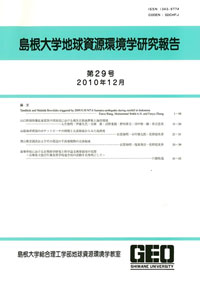島根大学総合理工学部地球資源環境学教室
ISSN:1343-9774

ダウンロード数 : ? 件
この文献の参照には次のURLをご利用ください : https://ir.lib.shimane-u.ac.jp/7321
島根大学地球資源環境学研究報告 27
2008-12-25 発行
山陽帯チタン鉄鉱系列酸性マグマの結晶分化作用に関する一考察 : 西南日本内帯加古川市花崗閃緑岩の角閃石から発見された波状累帯構造を指標として
Magmatic differentiation of ilmenite series granitoids in San-yo belt. : discovery an oscillatory zoning of amphiboles in granodiorite in the Kakogawa area, southwest Japan
川勝 和哉
青山 えりか
ファイル
内容記述(抄録等)
Medium-grained Cretaceous to late Paleogene hornblende-biotite granodiorites are distributed from east to west in Kakogawa as small masses about 1 km×2 km in size. The granodiorites are thought to be a part of a batholith around the Sea of Harima, and belong to the ilmenite series granitoids in the San-yo belt. Oscillatory zoning was discovered in the amphiboles in the Kakogawa granitoids.
The granitoids contain automorphic ilmenite in the pale green rims of automorphic amphiboles. This shows that oxygen fugacity was not so high, and indicates reducing conditions in the early stages of magmatic differentiation. Following that, the outer parts of the amphiboles reequilibrated, and pale brown cores and pale green rims were formed by replacement of the primary stage, due to fluid circulation under subsolidus conditions. Moreover, replacement of the secondary stage by fluid circulation continued, and oscillatory zoning formed in the pale green rims of the amphiboles by sudden oxidation of the remaining magmatic fluid. At the same time ilmenite re-equilibrated into a combination of rutile and sphene among the amphiboles and other crystals. The oscillatory zoning, which has developed only in automorphic apatite in the pale green rims of the amphiboles, shows that the oscillatory zoning formed after replacement, by fluid circulation of the primary stage. The oscillatory zones are a few micrometers wide, with a form like a cross-lamina structure. This developed in the direction of c-axis.
The San-yo and San-in granitoid belts became active at the same time, but differ greatly in the extent of oxidation of their early magmatic differentiation stages. However, there are some similarities, such as the same oscillatory zoning of amphiboles. Using this as an index, contrasted with granitoids of both belts, suggest the temperature and pressure conditions after the late magmatic differentiation were alike in both belts.
The granitoids contain automorphic ilmenite in the pale green rims of automorphic amphiboles. This shows that oxygen fugacity was not so high, and indicates reducing conditions in the early stages of magmatic differentiation. Following that, the outer parts of the amphiboles reequilibrated, and pale brown cores and pale green rims were formed by replacement of the primary stage, due to fluid circulation under subsolidus conditions. Moreover, replacement of the secondary stage by fluid circulation continued, and oscillatory zoning formed in the pale green rims of the amphiboles by sudden oxidation of the remaining magmatic fluid. At the same time ilmenite re-equilibrated into a combination of rutile and sphene among the amphiboles and other crystals. The oscillatory zoning, which has developed only in automorphic apatite in the pale green rims of the amphiboles, shows that the oscillatory zoning formed after replacement, by fluid circulation of the primary stage. The oscillatory zones are a few micrometers wide, with a form like a cross-lamina structure. This developed in the direction of c-axis.
The San-yo and San-in granitoid belts became active at the same time, but differ greatly in the extent of oxidation of their early magmatic differentiation stages. However, there are some similarities, such as the same oscillatory zoning of amphiboles. Using this as an index, contrasted with granitoids of both belts, suggest the temperature and pressure conditions after the late magmatic differentiation were alike in both belts.
Other Article
